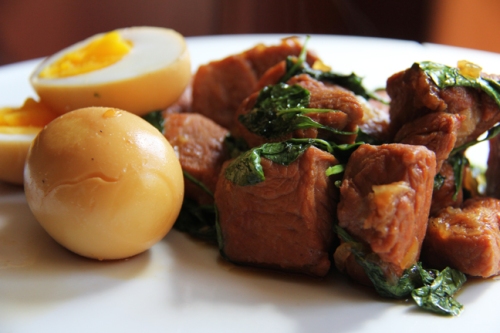Colloquially, the term caramelization is used to refer to the browning of food; The “bake until golden brown and delicious” you’ll find littered on every third page of every cookbook written between 1974 and the present. Technically speaking, however, caramelization is only browning due to the cooking of sugars, as opposed to the browning of amino acids (proteins) like searings a steak or roasting a chicken, which is known as The Maillard Reaction. As wikipedia puts it, caramelization is a “complex, poorly understood process” . But anybody familiar to desserts or candy making will tell you that browning sugar creates a rich, nutty flavor that pairs well with nearly everything. It’s time to break out Grandad’s old candy jar for the 19th week of Reddit’s 52 Weeks of Cooking Challenge!
Most people are familiar with the standard uses of caramel for sweet applications: butterscotch, creme brulee or flan, or even topped on your favorite sundae. However, caramelized sugar can take on a totally contrasting flavor when used in savory applications. Caramelized, and in some cases burnt, sugar can bring out natural flavors of meat and fish and add a subtle roasted flavor without the longer cooking process. A perfect example of this idea is in the traditional Vietnamese dish Thit Heo Kho Trung.
Thit Heo Kho Trung is a simple dish of pork, braised in caramel and coconut water and normally served with hard-boiled eggs. At the local Thai market, they sell these vacuum packages of pork and raw eggs and it always confused me as to what you could actually do with that, but now I think it may be for some kind of dish related to this. To make the caramel, sugar is combined with a little bit of water to moisten it, then cooked on high heat until it reaches a deep brown color. Adding pork, onions and garlic into the caramel begins to flavor the base and render fat out of the pork (similar to the way you may finish a caramel sauce with butter or cream). The main braising liquid consists of coconut water with a little fish sauce for that extra kick of umami that Asian cuisine is known for. The pork gets simmered until tender, then served up over rice, noodles, or just by itself. My original intention was to braise some bok choy in with the pork, but it slipped my mind at the grocery store and I ended up throwing some kale in. Hard boiled eggs are the traditional accompaniment to the pork, getting a quick simmer in the braising liquid to pick up some of the color and flavor of the caramel and pork. This dish wasn’t as sweet as I expected, but still had a rich caramel flavor; subtly enough to complement the other ingredients, but strong enough to let you know that it’s there. While an unusual combination, the hard boiled eggs made a very nice addition to the whole meal. Thit Heo Kho Trung is definitely going to be added to my dinner roster for my future day(s) off: Simple enough to make for one person but impressive enough to make for company, it could just as easily be made in a single morning (like I did) or thrown in a crock pot to cook overnight.
I would like to dedicate this post to the memory of my dear friend Mariah Woodward, who passed away in 2012 from chronic illness. Today would have been her 23rd birthday. Rest easy, Mariah.
Thit Heo Kho Trung, Vietnamese Caramel-Braised Por
makes about 2 servings
- Granulated Sugar, 1/2 cup
- Water, 1/2 cup
- Pork shoulder, cut into 1″-2″ chunks, about 1 pound
- Onion, thinly sliced, 1 each
- Garlic, minced or crushed, 2 cloves
- Coconut Water, about 16 fluid ounces
- Fish Sauce, to taste
- Kale, Bok Choy, or other vegetables, about 2 cups (optional)
- Eggs, hard boiled, peeled, 2 each
In a medium sauce pot, combine sugar and water. Cook over medium-high heat until sugar becomes a deep brown color, about 7 minutes. Add pork, onion and garlic, stirring to coat with caramel. Add coconut water and fish sauce and bring to a simmer. Cook over low heat until pork is tender, about 1 hour. 15 minutes before the pork is done, add vegetables (if using) and eggs, mixing to coat evenly with braising liquid. Serve hot over rice, noodles, or by itself.

